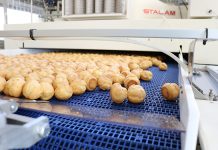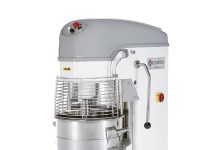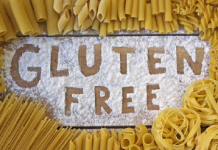Long pasta
 Concerning the lines for long pasta, the easiest way to move the rods is to position the empty ones on the prepared accumulation, usually at the entrance of the spreader. Output rods are placed manually and in an organized manner on the rod holders of the empty tray by the operator. At this stage increasing production capacity requires the operator’s continuous intervention; he also has to move the cart full of pasta inside the drying cells and replace the empty one near the discharging area of the spreader to start the rod loading again. The robot for rods makes this stage automated which, thanks to a system of accumulation and to the safety cage, will not have downtime and will operate in maximum safety. Shortly before packaging the rods, it is necessary to remove long and dried pasta – except for the case in which special formats complete with bow are packaged – cut the bow of pasta, remove it and have the two strands of pasta just separated. The used unit is the extracting machine / trimmer and can be fed manually or automatically; in this case it is possible to use a robot for feeding the extracting machine. It might be the same as that at the end of line and thus it can operate on both rods with fresh pasta (loaded on carts for drying) and on the rods with dry pasta (loaded on carts coming from drying). In some cases, it is preferable to separate these two functions, for which near the extracting machine/trimmer there has to be a robot dedicated to loading, distinct from that positioned at the end of line near the discharge spreader.
Concerning the lines for long pasta, the easiest way to move the rods is to position the empty ones on the prepared accumulation, usually at the entrance of the spreader. Output rods are placed manually and in an organized manner on the rod holders of the empty tray by the operator. At this stage increasing production capacity requires the operator’s continuous intervention; he also has to move the cart full of pasta inside the drying cells and replace the empty one near the discharging area of the spreader to start the rod loading again. The robot for rods makes this stage automated which, thanks to a system of accumulation and to the safety cage, will not have downtime and will operate in maximum safety. Shortly before packaging the rods, it is necessary to remove long and dried pasta – except for the case in which special formats complete with bow are packaged – cut the bow of pasta, remove it and have the two strands of pasta just separated. The used unit is the extracting machine / trimmer and can be fed manually or automatically; in this case it is possible to use a robot for feeding the extracting machine. It might be the same as that at the end of line and thus it can operate on both rods with fresh pasta (loaded on carts for drying) and on the rods with dry pasta (loaded on carts coming from drying). In some cases, it is preferable to separate these two functions, for which near the extracting machine/trimmer there has to be a robot dedicated to loading, distinct from that positioned at the end of line near the discharge spreader.
Short and long pasta
 Some manufacturers of systems for the production of pasta have, for some time, designed and installed dry pasta systems which allow obtaining long and short formats on the same production line. Production start will be provided with the above-described automated systems with no special precautions, while in the end of line, it is possible to automate the outlet both of frames and rods with a single robot. Here one can also add the option of taking rods with dried pasta intended for extracting machine/trimmer.
Some manufacturers of systems for the production of pasta have, for some time, designed and installed dry pasta systems which allow obtaining long and short formats on the same production line. Production start will be provided with the above-described automated systems with no special precautions, while in the end of line, it is possible to automate the outlet both of frames and rods with a single robot. Here one can also add the option of taking rods with dried pasta intended for extracting machine/trimmer.
Automatisms and main advantages
Certainly at a first glance, choosing to automate some production steps or to do it later in the business and production life of the system requires primarily economic assessment. How convenient it is to invest in automated systems and how convenient it is to have operators devoted to the above-described manual operations? First of all the assessment must take into account the production capacity of the line, the number of production shifts and labor cost, and the country in which the production system is installed or is working. Another big difference concerns the production of long or short pasta. As a matter of fact, in the case of short pasta, the same operator can normally manage both loading of empty frames at the beginning of the line and stacking the frames at the end of line; the production capacity has great importance because as it increases, also the speed of the frames along the line increases and, consequently, also the risk that human intervention cannot make up for both activities in due time. In the case of long pasta, the same criterion is applied, even penalized if one chooses to bring long dried pasta to extracting machines: the advice is normally to make use of two operators. Let us explain: the operator working at the end of line to fix the rods on the carts must also load the empty rods at the beginning of the line, at the entrance of the spreader; the time intervals are similar. Therefore, the main advantage is obvious: automation reduces the risk of downtime and allows the user to play a role mainly as supervisor and better manage business quality. Since it is difficult to write and to estimate the real cost of investment and operation, it is enough to highlight how working on more than one shift is certainly necessary to make use of different operators and that at high productions there are usually two operators. Finally, taking into account, for example, a multi-year investment plan, without doubt automatisms save interesting figures in specific production situations: countries with high labor costs, production lines with high production capacities near lines with continuous drying, working on several shifts.



